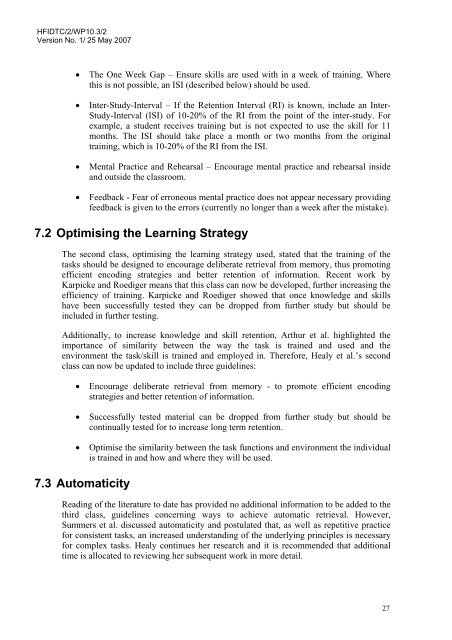Literature Review on Skill Fade - Human Factors Integration ...
Literature Review on Skill Fade - Human Factors Integration ...
Literature Review on Skill Fade - Human Factors Integration ...
Create successful ePaper yourself
Turn your PDF publications into a flip-book with our unique Google optimized e-Paper software.
HFIDTC/2/WP10.3/2<br />
Versi<strong>on</strong> No. 1/ 25 May 2007<br />
• The One Week Gap – Ensure skills are used with in a week of training. Where<br />
this is not possible, an ISI (described below) should be used.<br />
• Inter-Study-Interval – If the Retenti<strong>on</strong> Interval (RI) is known, include an Inter-<br />
Study-Interval (ISI) of 10-20% of the RI from the point of the inter-study. For<br />
example, a student receives training but is not expected to use the skill for 11<br />
m<strong>on</strong>ths. The ISI should take place a m<strong>on</strong>th or two m<strong>on</strong>ths from the original<br />
training, which is 10-20% of the RI from the ISI.<br />
• Mental Practice and Rehearsal – Encourage mental practice and rehearsal inside<br />
and outside the classroom.<br />
• Feedback - Fear of err<strong>on</strong>eous mental practice does not appear necessary providing<br />
feedback is given to the errors (currently no l<strong>on</strong>ger than a week after the mistake).<br />
7.2 Optimising the Learning Strategy<br />
The sec<strong>on</strong>d class, optimising the learning strategy used, stated that the training of the<br />
tasks should be designed to encourage deliberate retrieval from memory, thus promoting<br />
efficient encoding strategies and better retenti<strong>on</strong> of informati<strong>on</strong>. Recent work by<br />
Karpicke and Roediger means that this class can now be developed, further increasing the<br />
efficiency of training. Karpicke and Roediger showed that <strong>on</strong>ce knowledge and skills<br />
have been successfully tested they can be dropped from further study but should be<br />
included in further testing.<br />
Additi<strong>on</strong>ally, to increase knowledge and skill retenti<strong>on</strong>, Arthur et al. highlighted the<br />
importance of similarity between the way the task is trained and used and the<br />
envir<strong>on</strong>ment the task/skill is trained and employed in. Therefore, Healy et al.’s sec<strong>on</strong>d<br />
class can now be updated to include three guidelines:<br />
• Encourage deliberate retrieval from memory - to promote efficient encoding<br />
strategies and better retenti<strong>on</strong> of informati<strong>on</strong>.<br />
• Successfully tested material can be dropped from further study but should be<br />
c<strong>on</strong>tinually tested for to increase l<strong>on</strong>g term retenti<strong>on</strong>.<br />
• Optimise the similarity between the task functi<strong>on</strong>s and envir<strong>on</strong>ment the individual<br />
is trained in and how and where they will be used.<br />
7.3 Automaticity<br />
Reading of the literature to date has provided no additi<strong>on</strong>al informati<strong>on</strong> to be added to the<br />
third class, guidelines c<strong>on</strong>cerning ways to achieve automatic retrieval. However,<br />
Summers et al. discussed automaticity and postulated that, as well as repetitive practice<br />
for c<strong>on</strong>sistent tasks, an increased understanding of the underlying principles is necessary<br />
for complex tasks. Healy c<strong>on</strong>tinues her research and it is recommended that additi<strong>on</strong>al<br />
time is allocated to reviewing her subsequent work in more detail.<br />
27
















